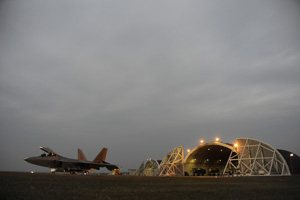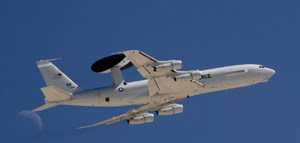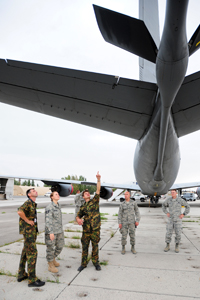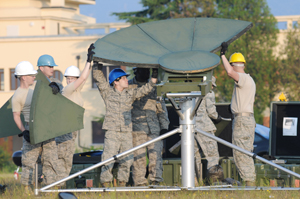For the near term, the operational Air Force is taking a nuts and bolts approach to today’s fights—squeezing more combat power out of its current aircraft fleet, pushing personnel and materiel into new locations, emphasizing new missions, building allied capabilities, and transitioning out of legacy platforms slated for retirement.
The Air Force is doing all of this with the understanding that the money will be tight. If the remarks of top USAF leaders and commanders are any guide—and they are—budget relief won’t be coming anytime soon.
 |
An F-22A is poised in front of a hardened shelter on the ramp at Kadena AB, Japan. |
Gen. Roger A. Brady, commander of United States Air Forces in Europe, made this point forcefully during a panel discussion with other senior leadership. “If you’re a commander, … you need to assume there isn’t going to be another dollar,” he declared. Even if additional funding does come, “it’s not going to get there during your watch, so you need to figure out what you’re going to do while you’re there.”
Commanders, Brady added, should not let airmen start “feeling sorry for themselves and feeling like they can’t solve any problem if it doesn’t have money attached to it.”
The view was echoed by the new head of Air Combat Command, Gen. William M. Fraser III. “Our Air Force today doesn’t look anything like it did in the late ’74 time period when I came aboard,” said Fraser. “And I am thankful for that because we have had the flexibility to do the things that we need to do.”
Airmen who are deployed and supporting Operation Iraqi Freedom and Operation Enduring Freedom have demonstrated great flexibility and are adapting a force that is constantly changing with the stresses of war in Southwest Asia.
Just as the institutional Air Force has changed, so have the wars in Iraq and Afghanistan.
Post-surge Iraq has largely stabilized, a political agreement between the US and Iraq is signed, and the military presence is steadily decreasing. Even so, said Secretary of Defense Robert M. Gates, demands for intelligence-surveillance-reconnaissance (ISR) capabilities continue to grow in both Iraq and Afghanistan.
This summer, USAF deployed its MC-12 turboprop ISR aircraft to Asia for the first time, as part of Project Liberty. Air Forces Central has reoriented its posture in the region and moved its most capable UAV assets—its MQ-9 Reaper fleet—into Afghanistan and shifted its available Predators to Iraq, said Gen. Gary L. North, the former AFCENT commander who assumed command of Pacific Air Forces in August.
As airpower adapted with the war, the job of supplying and sustaining forward deployed troops has become ever more critical, said Gen. Duncan J. McNabb, head of US Transportation Command.
“The movement of our forces and the resupply of those forces [are] obviously foremost on my mind,” he said. “That becomes harder [in] a place like Afghanistan.”
 |
An E-3 AWACS takes off. |
Blistering Rates
McNabb praised the work of Air Mobility Command and the Civil Reserve Air Fleet for helping to find new logistical solutions to what is one of the most rugged regions on the planet. The use of the Joint Precision Airdrop System, the steerable, GPS guided parachute, has given coalition forces “tremendous leverage” when performing resupply, McNabb added—helping to free up valuable ground convoys and helicopters to perform other missions in country.
Combat air forces are also rising to the challenge of today’s wars, but some leaders raised concerns about long-term effects of the demands. At Air Force Special Operations Command, Lt. Gen. Donald C. Wurster praised the tireless work of the AC-130 gunship crews, noting that they are flying at blistering rates and that the average gunship crew can claim credit for the destruction of “hundreds of our enemies.” But the oldest of the fleet, the AC-130Hs, have been flying since the early 1970s.
“We’ve got the nose up on that and we’re in a climb, but it’s a long way to level off,” Wurster said of his Vietnam-era C-130 fleet, which includes many of the gunships and other special operations transport aircraft.
The hole in the force structure that troubles him most, however, is the lack of forward based special operations rotorcraft. The CV-22 is coming online slowly and in limited numbers, and the MH-53 Pave Low fleet is now retired. “We do not have permanently based assets” in the Pacific, Europe, or Africa, Wurster said, adding that this was a topic he’d bring up in 2012 budget discussions.
ACC’s Fraser, having taken over the command just days before, raised concerns about how the explosion of airmen needed in the UAV field would affect professional development. “We’ve got to get to some sort of normalization,” he said, because the relentless push to add more CAPs is putting large demands on airmen.
“Basically, what we have going on in this career field … is the inability then to allow those who are operating these systems to move on to continue their careers and be developed,” Fraser said. If the Air Force is not careful, it will mortgage its future by burning out the UAV cadre, and the service runs the risk of the UAV operator being perceived as part of a “Stop-Loss” career field, Fraser warned. The demands placed on unmanned vehicle operators could preclude them from attending Air University in preparation for higher leadership positions, for example.
“If we don’t normalize it, before too long, we may have some real problems out there,” Fraser said.
For the mobility force, the rise and fall of optempo has given way to a “steady state” of missions across the globe, the head of Air Mobility Command said.
Air mobility forces have had a “banner year” since last September, Gen. Arthur J. Lichte said, noting that the fleet continues to break records on a regular basis—more than 13.1 million passengers have been flown on AMC airlift since September 2008.
Missions have ranged from humanitarian relief efforts in Guatemala to transport of heavy equipment for United Nations and African Union peacekeepers operating in Sudan’s Darfur region.
AMC also moved assets to aid the Afghan buildup this year, establishing a shuttle route using C-17s from Manas AB, Kyrgyzstan, and deploying an Army Stryker brigade to Afghanistan by flying it up from Diego Garcia.
Despite the high operations tempo, the Air Force has to make room on its ramps and intends to retire some of its oldest C-5As, as new C-17s come online. With Congress now appropriating funds for 213 C-17s (up from 205), USAF needs space to operate those aircraft, Lichte said.
 |
Members of USAF’s 376th Expeditionary Aircraft Maintenance Squadron and Kyrgyzstan Ministry of Defense representatives examine the refueling boom of a KC-135 Stratotanker at Manas AB, Kyrgyzstan. |
AMC has drawn up a list of the poorest performers of the fleet, and for every C-17 over 205, the Air Force plans to make a “one-for-one exchange” by retiring an underperforming C-5A.
However, “if we’re not allowed to manage our fleet, it creates lots of problems,” he said—and relief from Congress may finally be on its way. Senate appropriators approved language for the Fiscal 2010 defense appropriations bill that would lift the C-5’s Congressional retirement restriction, but Lichte said he will not proceed until he has signed legislation on his desk.
And while the health of the mobility fleet is fairly solid, Lichte gave a D to his tanker fleet, cautioning “if we don’t get [a replacement] on contract pretty soon, we’ll be giving it an F.”
The KC-135 and KC-10 fleets are performing admirably, but in the next 10 years, the cost to keep them flying is going to explode, as the Air Force will have to look at reskinning and rewiring some of the remaining KC-135s. This could swell sustainment costs for the fleet into the neighborhood of $6 billion a year.
F-35 Basing Questions
AMC maintainers are working hard to find new efficiencies, such as improvements to extend the life of the fleet’s braking system. KC-135 trim stabilizers have been modified as well. Seven to 10 hours on the ground are required for every hour a tanker flies in the air, Lichte said, a ratio which will rise every year the KC-X replacement is delayed. Soon, he added, the Air Force will even have to look at modernizing the avionics of the “new” tanker—the 25-year-old KC-10.
“We need to keep the KC-10s flying until about the year 2045,” Lichte said. “It’s important that we continue to take care of modifications.”
Unlike the uncertain future for mobility aircraft, the future course for fighters is now reasonably well-understood, and Air Force leaders feel the service will benefit from the new arrangements—as long as the integration process for aircraft such as the F-35 is well-managed.
An unresolved issue relating to the stand-up of the Air Force’s F-35 fleet is how to base the fighters for the air sovereignty alert mission—traditionally the task of the Air National Guard. Combat air force fighter reductions and scheduled retirements will soon lead to a capability shortfall for the ANG.
Lt. Gen. Harry M. Wyatt III, ANG director, noted the Guard fighter fleet’s age is a bit higher on average than the active duty force, and most F-16s performing the ASA mission today will be retired by 2018. Most Air Guard units won’t receive F-35s until the early 2020s, creating a fighter shortfall. Wyatt made the case that USAF should consider splitting off 30 percent of the F-35 production line once it’s running full tilt by 2015 (at about 24 aircraft a year) and send them to the Guard, helping to plug the gap. By the time the Air Force has fielded around 400 of the new fighters, a large portion would then reside with the ANG, creating a more rounded force, better able to address both homeland defense missions and support deployments.
USAF and the Air Guard are studying the situation, said Gen. Craig R. McKinley, National Guard Bureau chief. McKinley agreed that sustaining the ASA mission will be difficult—and cautioned any solution will be “complicated.”
The Air Reserve Components are critical to the deployment of the F-35 and success in other Air Force missions, said Lt. Gen. Charles E. Stenner Jr., head of Air Force Reserve Command. The key in these missions is to ensure a “continuity of service” for separating active duty airmen who wish to continue serving. Smooth transitions will allow AFRC to help “fix” stressed active duty career fields.
New missions such as UAV operations and intelligence analysis in some cases allow Reservists to volunteer for deployments, without separation from their families or employers, by joining Reserve intelligence or cyber warfare units.
Loss of “dwell time” spent at home station is a huge concern for the Reserve, Stenner said. For every drop in the deployment ratio (from a one-to-five ratio to a one-to-four, for example), the Air Force loses 10 percent of its Reserve airmen. The Fiscal 2012 budget, Stenner added, will work to lower the operations tempo on airmen working in security forces, engineering, and unmanned aerial vehicle operations.
 |
Two F-15s form up with a Lithuanian Air Force L-39 Albatross on a training exercise over Siauliai, Lithuania. (USAF photo) |
The unique capabilities and assets of the Air Guard have already proved invaluable to the expansion of UAV missions, Wyatt noted. Units are operating or standing up flight operations for MQ-1 Predators and MQ-9 Reapers in California, Arizona, Texas, New York, and other locations. Many of these units are filled with veterans of fighter operations who have moved on, are highly skilled, and are volunteering for the growth-mission area as the Pentagon pushes UAV expansion.
USAF’s newest domain of operations has great opportunities for active and reserve component airmen as well. Gen. C. Robert Kehler, head of Air Force Space Command, said that today’s airmen are better than ever at exploiting the connectivity between air, space, and cyberspace. Since 2001, airmen have utilized “cross domain integration” unlike in any other conflict.
“I think our airmen have broken the code on how you integrate air and space,” Kehler said.
Airmen have recognized how space fits into all aspects of the fight, from GPS satellites to secure communications. Kehler noted the inside of a ground control element is completely separated from its geographical location—thanks to space-based capabilities. “If you close the door, you don’t know where you are. … You’re in everybody’s [area of responsibility]. That’s a huge change.”
A Growth Industry
The Air Force’s cyber warfare arm, 24th Air Force is now building capability and consolidating mission areas, he said. The 67th Network Warfare Wing and the 688th Information Operations Wing, both at Lackland AFB, Tex., are up and running. Approval took place Oct. 5 for the stand-up of the third cyber wing, the 689th Combat Communications Wing. The three wings will help stabilize the service’s networks and focus on mission assurance, Kehler said, and help standardize the many computer networks spanning the Air Force.
“It isn’t about trying to protect everything, everywhere, all the time,” Kehler said of mission assurance efforts. “It’s about making sure we can do the mission under duress.” The goal of Air Force cyber warfare airmen is to make it difficult for adversaries to operate in cyberspace.
Outside of the war zone, USAF’s commanders are increasingly concerned with partnership-building activities. Capable and interoperable allies are critical to the success of military missions worldwide, from humanitarian efforts to ensuring interoperable communications in war.
Gen. Stephen R. Lorenz, head of Air Education and Training Command, said partnership building has received attention at the highest levels of the service.
“I think it’s a growth industry,” Lorenz said, noting the service’s air advisor program has expanded and a strategic campaign plan has been assembled to integrate all aspects of development for both US airmen and allies and to help commanders reach out to allies around the world. A growing share of joint engagement tasks is falling on general-purpose forces, USAFE’s Brady pointed out, which makes proper resourcing and balancing even more critical.
North, the new PACAF commander, echoed this sentiment. Soon after arriving on the job, he began making plans to visit with key Pacific allies such as Japan in late September, he told reporters. Japan’s government is studying its future aircraft requirements and may still pursue an export F-22 variant, although time is running out on that option.
Despite their geographic distance, the expeditionary nature of the modern Air Force means both USAFE and PACAF contribute heavily to the war effort in Asia. Brady said that of his eight fighter squadrons, anywhere from one to three of them are in Iraq or Afghanistan at any one time. By next year, USAFE will have only 150 permanently based fighters on the European continent—at a time when the demands of engagement and capacity-building efforts with new European allies are expanding.
In Europe, engagement with allies is vital to long-term US strategy. The NATO alliance has expanded from 16 nations to 28 in just over a decade. But with that expansion, serious capability gaps have emerged with allies. “I think it’s getting a little worse,” Brady said, because only five nations meet the NATO goal of spending at least two percent of GDP on defense (including the United States).
 |
Airmen from the 1st Combat Communications Squadron at Ramstein AB, Germany, set up a satellite dish during a training exercise at Aviano AB, Italy. (USAF photo by SSgt. Patrick Dixon) |
There are three tiers of air capability in NATO, Brady said. Thirteen nations are highly effective, interoperable, and deployable—the top tier.
Six more allies have top-notch aviators but field mostly Warsaw Pact-era equipment and are therefore not generally deployable.
The rest are “nascent” and support barely functional air elements that need additional investment.
Many of these allies with developing air arms have deployed forces to Iraq and Afghanistan, but lack modernized equipment and training. This is a gap USAFE and US European Command must help close, Brady said.
“Our policies and actions as nations and air forces can affect both the will and the capabilities of these nations today and going forward,” he said.